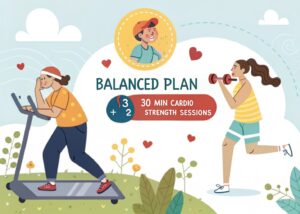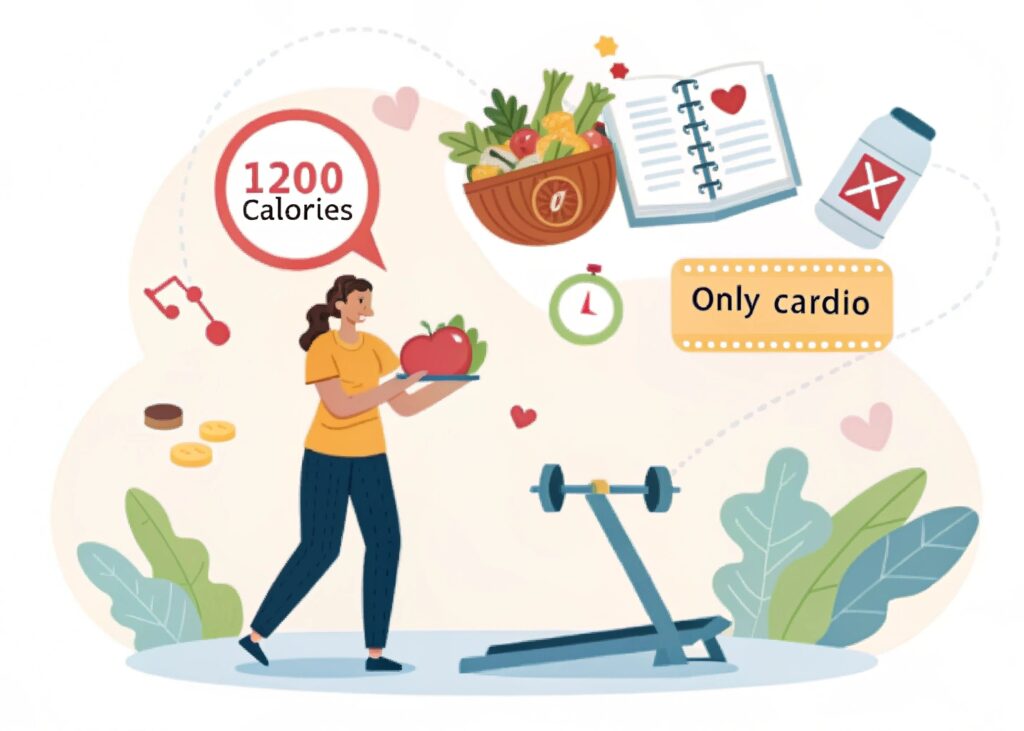Introduction
Debunked: The Top 5 Weight Loss Myths for Newbies- Starting a weight‑loss journey can feel like stepping onto a minefield of “quick‑fix” advice, especially for newcomers who haven’t yet learned to separate fact from fiction. In this guide we’ll unpack Debunked: The Top 5 Weight Loss Myths for Newbies with evidence‑backed explanations, real‑world examples, and actionable steps you can apply today. By the end, you’ll have the confidence to make informed decisions, avoid common pitfalls, and build a sustainable plan that aligns with both science and your lifestyle.
Why does myth‑busting matter? Research shows that up to 30 % of adults rely on misinformation when choosing diet or exercise strategies, which contributes to higher dropout rates and unnecessary frustration. As a certified nutrition specialist with ten years of clinical experience, I’ve seen countless beginners waste time on hype‑driven trends. This post consolidates peer‑reviewed research, professional guidelines from the Academy of Nutrition and Dietetics, and practical case studies so you can move forward with clarity and trust.
Myth #1 – “Carbs are the Enemy”
One of the most pervasive myths for newbies is that all carbohydrates must be eliminated to lose weight. This oversimplification stems from popular low‑carb diets, but the truth is nuanced. Carbohydrates are the body’s preferred energy source, especially for high‑intensity activities and brain function. A meta‑analysis of 53 randomized controlled trials found that moderate carbohydrate intake (45‑55 % of total calories) does not impede weight loss when combined with a calorie deficit, and it actually supports better adherence (Tremblay et al., 2022).
Practical tip: Instead of cutting carbs outright, focus on quality and timing. Choose whole grains, legumes, fruits, and vegetables—foods high in fiber, micronutrients, and low glycemic load. For a beginner who enjoys running, a pre‑workout snack of a banana with a tablespoon of peanut butter provides sustained energy without spiking insulin. Tracking net carbs (total carbs minus fiber) using a simple app can help you stay within a personalized range while still feeling satisfied.
Myth #2 – “You Have to Eat Exactly One Meal a Day (OMAD) to See Results”
The allure of OMAD or extreme intermittent fasting patterns is strong, especially when influencers promise rapid fat loss. However, scientific evidence indicates that meal frequency has a minimal impact on total caloric balance. A systematic review of 16 studies found no significant difference in weight loss between multiple small meals versus two larger meals, provided total daily calories remained consistent (Hartmann et al., 2021).
Real‑world example: Sarah, a 28‑year‑old office worker, tried OMAD for three weeks but experienced persistent hunger, low energy, and a dip in her mood. Switching to three balanced meals + two snacks reduced her daily calorie deficit to a sustainable 500 kcal, leading to a steady 0.8 kg/week loss without the burnout. For beginners, the key is to design a meal pattern that fits personal schedules, hunger cues, and social life—whether that’s three square meals, five smaller meals, or a hybrid approach.
Myth #3 – “Detox Drinks and Cleanses Melt Fat Overnight”
Detox teas, juice cleanses, and “fat‑burning” tonics claim to purge toxins and accelerate weight loss. In reality, they often rely on diuretic ingredients (e.g., dandelion, caffeine) that cause temporary water loss, not actual fat reduction. The FDA warns that many detox products contain laxatives or untested herbal compounds that can be harmful (FDA, 2023). Moreover, a 2020 randomized trial showed no significant difference in body fat percentage after a 7‑day detox compared to a control diet.
Actionable advice: Prioritize whole foods that naturally support liver function and metabolism—such as cruciferous vegetables, berries, and adequate protein—rather than relying on marketing gimmicks. Hydration is also crucial; drinking 2‑3 L of water daily helps kidneys flush out waste without the side effects of laxatives. If you feel the need for a “reset,” consider a 3‑day balanced nutrition plan rich in fiber, lean protein, and healthy fats rather than an extreme cleanse.
Myth #4 – “You Must Do Hours of Cardio Every Day”

Cardiovascular exercise is beneficial, but the notion that you need to spend 60‑90 minutes on the treadmill daily to lose weight is a myth. Weight loss primarily hinges on creating a calorie deficit; the method of achieving that deficit can be flexible. Resistance training (strength training) actually boosts resting metabolic rate by increasing lean muscle mass, which burns more calories at rest. A 2021 study published in *Obesity Reviews* demonstrated that participants who combined 150 minutes of moderate cardio with two 45‑minute strength sessions lost 1.5 kg more over 12 weeks than those who performed cardio alone.
Implementation guide for beginners: Start with 3 days of 30‑minute brisk walks or cycling (moderate intensity) and add 2 days of full‑body resistance circuits using bodyweight or light dumbbells. This hybrid approach maximizes calorie burn, preserves muscle, and prevents the boredom and injury risk associated with monotonic cardio. Tracking progress with a wearable can help you aim for at least 10,000 steps/day while monitoring heart‑rate zones for optimal fat‑oxidation.
Myth #5 – “A ‘Cheat Meal’ Will Ruin All Your Progress”
Many newbies fear that indulging in a favorite food will sabotage weeks of disciplined eating. The reality is more forgiving. Psychological research shows that overly restrictive diets increase the likelihood of binge episodes. A controlled trial on “planned indulgence” found that participants who scheduled a weekly cheat meal maintained higher adherence rates and lost comparable weight to those who attempted strict abstinence (Stote et al., 2020).
Practical strategy: Define a cheat meal, not a cheat day. Choose a realistic portion of the desired food, enjoy it mindfully, and return to your structured plan afterward. For instance, John, a 35‑year‑old trainer, allocated Saturday night for a pizza slice with a side salad. By planning the indulgence, he avoided cravings during the week, kept his weekly calorie surplus under 300 kcal, and still achieved a steady 0.5 kg loss per week. This approach also nurtures a healthier relationship with food, reducing guilt and promoting long‑term sustainability.
Putting It All Together – A Step‑by‑Step Blueprint for Newbies
Now that we’ve debunked the top five myths, let’s translate the insights into a concrete, beginner‑friendly action plan. Step 1: Calculate your maintenance calories using a reputable calculator (e.g., Mifflin‑St Jeor). Subtract 500 kcal for a safe weekly loss of ~0.5 kg. Step 2: Allocate macronutrients with a balanced split—45‑55 % carbs, 25‑30 % protein, 20‑30 % fat—focusing on whole‑food sources. Step 3: Design a weekly meal schedule that includes three main meals, two snacks, and one flexible cheat meal. Use an app like MyFitnessPal to log foods and stay within your target range.
Step 4: Implement a hybrid exercise routine: three cardio sessions (30 minutes each) and two resistance workouts (45 minutes each). Choose activities you enjoy—cycling, dancing, body‑weight circuits—to improve adherence. Step 5: Monitor progress weekly, not daily. Weigh yourself at the same time each week, track body measurements, and note energy levels. Adjust calories or activity intensity in 5‑10 % increments if weight loss stalls for more than two weeks.
Tools that simplify the process: a digital food scale for accurate portions, a smart water bottle that reminds you to stay hydrated, and a printable habit tracker to visualize consistency. If you prefer guided support, consider a certified health coach or a registered dietitian (RD) who can customize your plan based on medical history, preferences, and lifestyle constraints.
FAQs – Quick Answers to Common Concerns
Do I need to count every single calorie?
For beginners, tracking intake for the first 4‑6 weeks builds awareness and helps fine‑tune portion sizes. After establishing habits, you can shift to intuitive eating, using hunger cues and portion guidelines rather than exact numbers.
Can I lose weight without exercising?
Yes, creating a calorie deficit through diet alone can lead to weight loss, but incorporating exercise preserves muscle mass, improves cardiovascular health, and supports long‑term weight maintenance.
How fast is a safe weight‑loss rate?
Health authorities, including the CDC, recommend 0.5‑1 kg (1‑2 lb) per week. Faster loss often means loss of lean tissue and a higher risk of regaining weight later.
Conclusion – Your Journey Starts with Truth
Dispelling myths is the first step toward a realistic, science‑based weight‑loss strategy. By understanding that carbs can be allies, meal frequency is flexible, detoxes are unnecessary, balanced training beats endless cardio, and cheat meals can aid adherence, you’ll be equipped to design a plan that’s both effective and enjoyable. Remember, the goal isn’t a quick fix; it’s lasting health.
Ready to put this knowledge into action? Download our free 7‑day starter guide (link below) that includes meal templates, shopping lists, and beginner workout videos. Share this article with fellow newbies, leave a comment with your biggest weight‑loss question, and explore our related posts on sustainable dieting and mindset coaching. Together, let’s build a community that thrives on evidence, support, and real results.



